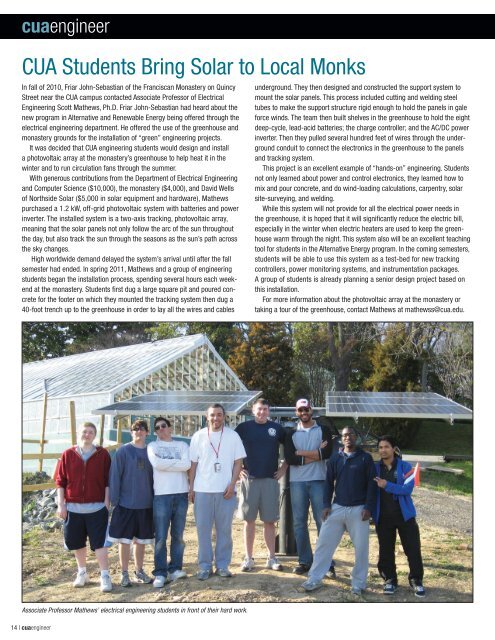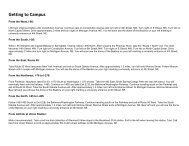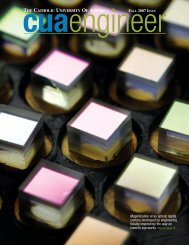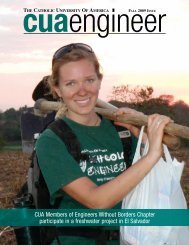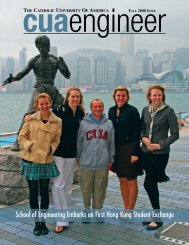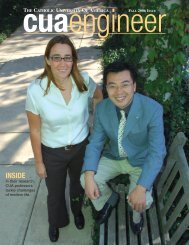Engineering New Frontiers Summer Camp - the School of ...
Engineering New Frontiers Summer Camp - the School of ...
Engineering New Frontiers Summer Camp - the School of ...
Create successful ePaper yourself
Turn your PDF publications into a flip-book with our unique Google optimized e-Paper software.
cuaengineer<br />
CUA Students Bring Solar to Local Monks<br />
In fall <strong>of</strong> 2010, Friar John-Sebastian <strong>of</strong> <strong>the</strong> Franciscan Monastery on Quincy<br />
Street near <strong>the</strong> CUA campus contacted Associate Pr<strong>of</strong>essor <strong>of</strong> Electrical<br />
<strong>Engineering</strong> Scott Ma<strong>the</strong>ws, Ph.D. Friar John-Sebastian had heard about <strong>the</strong><br />
new program in Alternative and Renewable Energy being <strong>of</strong>fered through <strong>the</strong><br />
electrical engineering department. He <strong>of</strong>fered <strong>the</strong> use <strong>of</strong> <strong>the</strong> greenhouse and<br />
monastery grounds for <strong>the</strong> installation <strong>of</strong> “green” engineering projects.<br />
It was decided that CUA engineering students would design and install<br />
a photovoltaic array at <strong>the</strong> monastery’s greenhouse to help heat it in <strong>the</strong><br />
winter and to run circulation fans through <strong>the</strong> summer.<br />
With generous contributions from <strong>the</strong> Department <strong>of</strong> Electrical <strong>Engineering</strong><br />
and Computer Science ($10,000), <strong>the</strong> monastery ($4,000), and David Wells<br />
<strong>of</strong> Northside Solar ($5,000 in solar equipment and hardware), Ma<strong>the</strong>ws<br />
purchased a 1.2 kW, <strong>of</strong>f-grid photovoltaic system with batteries and power<br />
inverter. The installed system is a two-axis tracking, photovoltaic array,<br />
meaning that <strong>the</strong> solar panels not only follow <strong>the</strong> arc <strong>of</strong> <strong>the</strong> sun throughout<br />
<strong>the</strong> day, but also track <strong>the</strong> sun through <strong>the</strong> seasons as <strong>the</strong> sun’s path across<br />
<strong>the</strong> sky changes.<br />
High worldwide demand delayed <strong>the</strong> system’s arrival until after <strong>the</strong> fall<br />
semester had ended. In spring 2011, Ma<strong>the</strong>ws and a group <strong>of</strong> engineering<br />
students began <strong>the</strong> installation process, spending several hours each weekend<br />
at <strong>the</strong> monastery. Students first dug a large square pit and poured concrete<br />
for <strong>the</strong> footer on which <strong>the</strong>y mounted <strong>the</strong> tracking system <strong>the</strong>n dug a<br />
40-foot trench up to <strong>the</strong> greenhouse in order to lay all <strong>the</strong> wires and cables<br />
Associate Pr<strong>of</strong>essor Ma<strong>the</strong>ws’ electrical engineering students in front <strong>of</strong> <strong>the</strong>ir hard work.<br />
14 | cuaengineer<br />
underground. They <strong>the</strong>n designed and constructed <strong>the</strong> support system to<br />
mount <strong>the</strong> solar panels. This process included cutting and welding steel<br />
tubes to make <strong>the</strong> support structure rigid enough to hold <strong>the</strong> panels in gale<br />
force winds. The team <strong>the</strong>n built shelves in <strong>the</strong> greenhouse to hold <strong>the</strong> eight<br />
deep-cycle, lead-acid batteries; <strong>the</strong> charge controller; and <strong>the</strong> AC/DC power<br />
inverter. Then <strong>the</strong>y pulled several hundred feet <strong>of</strong> wires through <strong>the</strong> underground<br />
conduit to connect <strong>the</strong> electronics in <strong>the</strong> greenhouse to <strong>the</strong> panels<br />
and tracking system.<br />
This project is an excellent example <strong>of</strong> “hands-on” engineering. Students<br />
not only learned about power and control electronics, <strong>the</strong>y learned how to<br />
mix and pour concrete, and do wind-loading calculations, carpentry, solar<br />
site-surveying, and welding.<br />
While this system will not provide for all <strong>the</strong> electrical power needs in<br />
<strong>the</strong> greenhouse, it is hoped that it will significantly reduce <strong>the</strong> electric bill,<br />
especially in <strong>the</strong> winter when electric heaters are used to keep <strong>the</strong> greenhouse<br />
warm through <strong>the</strong> night. This system also will be an excellent teaching<br />
tool for students in <strong>the</strong> Alternative Energy program. In <strong>the</strong> coming semesters,<br />
students will be able to use this system as a test-bed for new tracking<br />
controllers, power monitoring systems, and instrumentation packages.<br />
A group <strong>of</strong> students is already planning a senior design project based on<br />
this installation.<br />
For more information about <strong>the</strong> photovoltaic array at <strong>the</strong> monastery or<br />
taking a tour <strong>of</strong> <strong>the</strong> greenhouse, contact Ma<strong>the</strong>ws at ma<strong>the</strong>wss@cua.edu.


